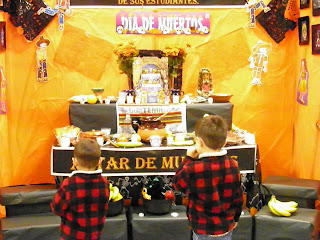
Did you get a chance to view the different Day of the Dead displays that were showcased throughout the CBC campus? If you did and know what it is about, I hope you enjoyed the displays and look for them again next year. If you did see them but don’t know their meaning continue reading this blog for more information and maybe next year you can appreciate them a little more.

What is Día de los Muertos/Day of the Dead?
Day of the Dead is a ritual that started over 3,000 years ago in Mexico. It used to be celebrated for an entire month in the 9th month of the Aztec calendar, which translates to the beginning of August. When the Spaniards arrived to Mexico and saw the natives celebrating this ritual they thought it barbaric and tried to eliminate it. The Spaniards couldn’t understand why they were embracing death rather than being afraid of it. The Aztec natives believed that death was a continuation of life rather than the end of life.
The Spaniards did their best to end the ritual when they tried to convert the Aztecs to Catholicism, but it just wouldn’t die. The missionaries prohibited traditional ritual events, but the importance was so great they had to make a compromise. So in their attempt to make the ritual more Christian they moved the date to coincide with church observed All Saint’s Day and All Soul’s Day (November 1st & 2nd), which is when it is celebrated today. And so the two cultures merged.

Symbolism
Day of the Dead is still celebrated in many parts of Mexico, mostly in areas with high indigenous populations and in the United States as a more public event. The ritual has a lot of symbolism and it is meant to celebrate that life continues after death. Día de los Muertos is celebrated with an offering to family members or friends that have passed away. The offering is set up as an altar, which contains different items depending on the region. The altar can display pictures, favorite foods or items, and other personal objects of the deceased. They also have skulls made of sugar or chocolate with the names of the people that have passed away, candles, and pan de muertos, which is bread unique to the event. In some regions, people spend the day at the cemetery decorating the grave site, eating favorite foods of the deceased, and honoring their spirits. Many believe that in doing this, the soul is attracted back to them on earth.


No comments:
Post a Comment